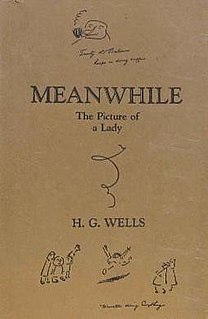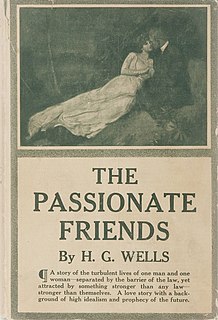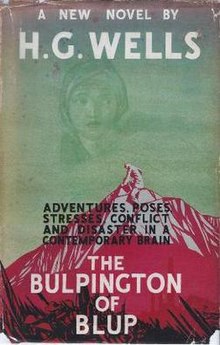
The Open Conspiracy: Blue Prints for a World Revolution was published in 1928 by H. G. Wells, when he was 62 years old. It was revised and expanded in 1930 with the additional subtitle A Second Version of This Faith of a Modern Man Made More Explicit and Plain. In 1931 a further revised edition appeared titled What Are We to Do with Our Lives? A final version appeared in 1933 under its original title. Many of its ideas are anticipated in Wells's 1926 novel The World of William Clissold.

The Outline of History, subtitled either "The Whole Story of Man" or "Being a Plain History of Life and Mankind", is a work by H. G. Wells chronicling the history of the world from the origin of the Earth to the First World War. It appeared in an illustrated version of 24 fortnightly installments beginning on 22 November 1919 and was published as a single volume in 1920. It sold more than two million copies, was translated into many languages, and had a considerable impact on the teaching of history in institutions of higher education. Wells modeled the Outline on the Encyclopédie of Denis Diderot.

The Wonderful Visit is an 1895 novel by H. G. Wells. With an angel—a creature of fantasy unlike a religious angel—as protagonist and taking place in contemporary England, the book could be classified as contemporary fantasy, although the genre was not recognised in Wells's time. The Wonderful Visit also has strong satirical themes, gently mocking customs and institutions of Victorian England as well as idealistic rebellion itself.

"The war to end war" is a term for the First World War of 1914–1918. Originally an idealistic slogan, it is now mainly used sardonically, since not only was the First World War not history's final war, but its aftermath also indirectly contributed to the outbreak of the even more devastating Second World War.

The World of William Clissold is a 1926 novel by H. G. Wells published initially in three volumes. The first volume was published in September to coincide with Wells's sixtieth birthday, and the second and third volumes followed at monthly intervals.

Meanwhile is a 1927 novel by H. G. Wells set in an Italian villa early in 1926.
The New Machiavelli is a 1911 novel by H. G. Wells that was serialised in The English Review in 1910. Because its plot notoriously derived from Wells's affair with Amber Reeves and satirised Beatrice and Sidney Webb, it was "the literary scandal of its day".
The Future in America: A Search After Realities is a 1906 travel essay by H. G. Wells recounting his impressions from the first of half a dozen visits he would make to the United States. The book consists of fifteen chapters and a concluding "envoy".

The Passionate Friends is a 1913 novel by H. G. Wells.
The Wife of Sir Isaac Harman is a 1914 novel by H. G. Wells.

An Englishman Looks at the World is a 1914 essay collection by H. G. Wells containing journalistic pieces written between 1909 and 1914. The book consists of twenty-six pieces ranging from five to sixty-two pages in length. An American edition was published the same year by Harper and Brothers under the title Social Forces in England and America.

Bealby: A Holiday is a 1915 comic novel by H. G. Wells.

War and the Future (1917) is a work of war propaganda by H. G. Wells that was published in North America under the title Italy, France, and Britain at War. Wells would have preferred the title The War of Ideas, but his publisher over-ruled him. Except for the opening piece, its chapters were published as articles in the press. Though proclaiming early in the volume that "I avow myself an extreme Pacifist," Wells staunchly supported Britain's war against Germany "in the hope that so we and the world may be freed from the German will-to-power and all its humiliating and disgusting consequences henceforth for ever."

The Undying Fire, a 1919 novel by H. G. Wells, is a modern retelling of the story of Job. Like the Book of Job, it consists of a prologue in heaven, an exchange of speeches with four visitors, a dialogue between the protagonist and God, and an epilogue in which the protagonist's fortunes are restored. The novel is dedicated "to All Schoolmasters and Schoolmistresses and every Teacher in the World."

Experiment in Autobiography is an autobiographical work by H.G. Wells, originally published in two volumes. He began to write it in 1932, and completed it in the summer of 1934.

A Year of Prophesying collects 55 newspaper columns written by H.G. Wells in 1923 and 1924.

Mr. Blettsworthy on Rampole Island is a 1928 novel by H. G. Wells.

Joan and Peter, a 1918 novel by H. G. Wells, is at once a satirical portrait of late-Victorian and Edwardian England, a critique of the English educational system on the eve of World War I, a study of the impact of that war on English society, and a general reflection on the purposes of education. Wells regarded it as "one of the most ambitious" of his novels.

Certain Personal Matters is an 1897 collection of essays selected by H. G. Wells from among the many short essays and ephemeral pieces he had written since 1893. The book consists of thirty-nine pieces ranging from about eight hundred to two thousand words in length. A one-shilling reprint was issued in 1901 by T. Fisher Unwin.

Anticipations of the Reaction of Mechanical and Scientific Progress upon Human Life and Thought, generally known as Anticipations, was written by H.G. Wells at the age of 34. He later called the book, which became a bestseller, "the keystone to the main arch of my work." His most recent biographer, however, calls the volume "both the starting point and the lowest point in Wells's career as a social thinker."

















